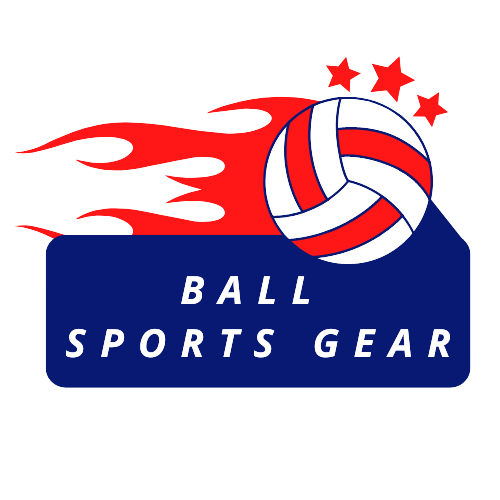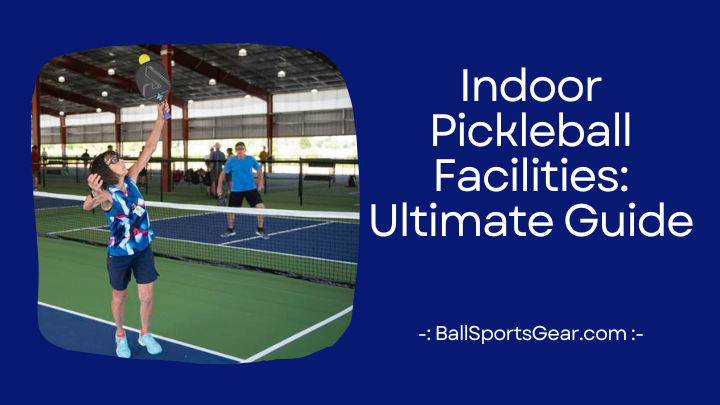Pickleball is a fun and exciting sport that combines elements of tennis, badminton, and ping-pong. It is played on a court with a net, paddles, and a plastic ball with holes. It can be played by people of all ages and skill levels, making it a great way to stay active and social. Pickleball is also one of the fastest-growing sports in the country, with an estimated 4.2 million players in 2020, according to the USA Pickleball Association.
As the popularity of pickleball increases, so does the demand for quality indoor pickleball facilities. Outdoor courts are subject to weather conditions, which can affect the playing surface, cause cancellations, or limit the playing season. However, an indoor pickleball facility provides courts with year-round protection, helping operations save money on routine upkeep and ensuring play can continue through any weather.
Using a Clear Span fabric structure, we’ll demonstrate how to plan, erect and run an indoor pickleball court in this post. In this article, we’ll go over the things to think about when building an indoor pickleball facility, the benefits of using a Clear Span fabric building for an indoor pickleball facility, the various cladding options for an indoor pickleball facility, and the amenities and features that can improve the playing experience and draw more visitors to an indoor pickleball facility.
Designing the Structure for an Indoor Pickleball Facility
Before constructing an indoor pickleball facility, there are several factors to consider, such as:
- The facility’s location and climate must be taken into account since they will have an impact on the enclosure objectives and insulation requirements of your building. For instance, to keep your construction warm and dry, you might wish to completely enclose and insulate it if you live in a chilly or wet region. In order to allow for natural ventilation and cooling, you might wish to partially open your structure if you live in a warm or sunny place.
- Goals of the enclosure. You must choose the type of apertures and the extent to which you wish to enclose your project. You could wish to install roll-up doors, sliding doors, windows, skylights, or vents, for instance.You will also need to consider the security and accessibility of your structure.
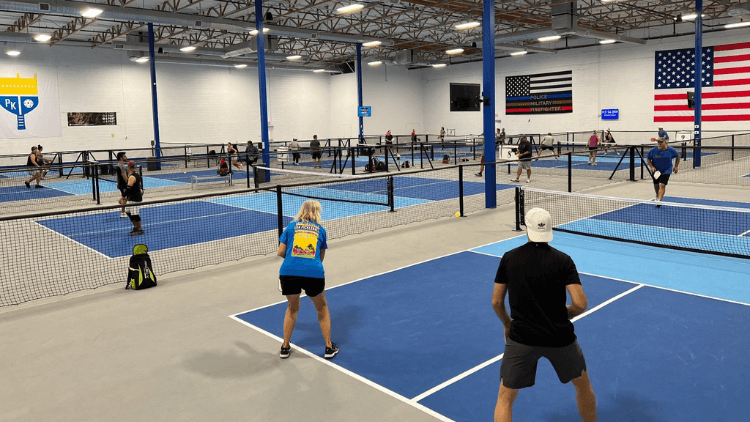
One of the best options for an indoor pickleball facility is a ClearSpan fabric building. A ClearSpan fabric building is a versatile and durable structure that can be customized to meet any requirements.
Here are some of the advantages of using a ClearSpan fabric building for an indoor pickleball facility:
- Natural lighting: A ClearSpan fabric structure has a translucent fabric cover that lets natural light pass through, producing a cheery playing area that is free of glare and shadows. Additionally, this eliminates the demand for artificial lighting and cuts the cost of utilities.
- Ventilation: The high ceiling of a ClearSpan fabric structure generates a natural chimney effect, which enables hot air to ascend and leave through vents or apertures. This produces a clean, cosy atmosphere that inhibits the formation of mould and humidity. Additionally, it cuts electricity bills and lessens the need for fans or air conditioning.
- Spaciousness: A ClearSpan fabric building has a clear span design that eliminates the need for internal support posts or beams. This allows for maximum usable space and flexibility in laying out courts. It also ensures that nothing will interfere with ongoing matches or obstruct views.
- Customization: A ClearSpan fabric building can be customized to fit any specifications. From size and shape to color and cladding, you can create your ideal structure with ClearSpan’s Building Specialists. You can also add any amenities or features you want, such as locker rooms, office space, heating systems, specialized doors, lighting plans, etc.
- Durability: A ClearSpan fabric building is made of high-quality materials that can withstand harsh weather conditions and last for decades. The fabric cover is UV-resistant, flame-retardant, rip-stop, and backed by a 20-year warranty. The steel frame is corrosion-resistant, galvanized or powder-coated, and backed by a 50-year warranty.
Choosing the Cladding for an Indoor Pickleball Facility
Another factor to consider when building an indoor pickleball facility is the type of cladding you want to use for your structure. Cladding is the material that covers the frame of your structure and provides protection, insulation, and aesthetics. There are different types of cladding options for an indoor pickleball facility, such as:
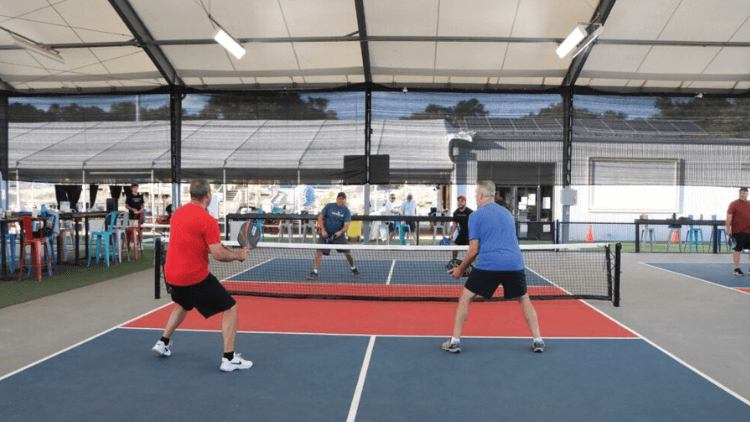
- Fabric: The most frequent and well-liked material for an indoor pickleball court is fabric. Fabric is a thin, adaptable material that is simple to attach and remove. Fabric offers the aforementioned natural illumination, ventilation, roominess, and customisation. Due to its minimal energy and resource requirements during production and transportation, fabric also has a low environmental effect.
- Metal: Another material to consider for a pickleball court indoors is metal. Strong and long-lasting, metal can survive fire, wind, and heavy snowfall. Your construction will seem more classic and industrial if it is made of metal. Additionally, metal has a high reflectivity, which can aid in lowering cooling expenses and heat gain.
- Hybrid: Hybrid is a combination of fabric and metal for an indoor pickleball facility. Hybrid allows you to have the best of both worlds, as you can use fabric for the roof and metal for the walls or vice versa. Hybrid provides a balance of natural lighting, ventilation, spaciousness, customization, and durability.
Each cladding option has its pros and cons, depending on your preferences, budget, and goals. Here are some of the pros and cons of each option:
- Fabric
- Pros: Natural lighting, ventilation, spaciousness, customization, low environmental impact, low cost
- Cons: Less insulation, less soundproofing, less security
- Metal
- Pros: Durability, fire resistance, reflectivity, security
- Cons: Less natural lighting, less ventilation, less spaciousness, less customization, high environmental impact, high cost
- Hybrid
- Pros: Balance of natural lighting, ventilation, spaciousness, customization, durability
- Cons: Higher cost than fabric alone
Your individual demands and preferences will determine the finest indoor pickleball facility. However, for an indoor pickleball facility, we advise choosing a ClearSpan fabric building with a fabric cover since it offers the most advantages and the fewest disadvantages for producing a pleasurable pickleball experience.
Enhancing an Indoor Pickleball Facility with Amenities
The extra features and facilities you want to include in your indoor pickleball facility should be the last thing you think about while planning it. Features and amenities are the extras that may improve the playing experience and draw more patrons to your establishment. You may add the following features and amenities to your indoor pickleball court:
- Locker rooms: Locker rooms are a convenient and comfortable place for players to store their belongings, change their clothes, shower, or use the restroom. Locker rooms can also provide privacy and security for players.
- Office space: Office space is a useful place for staff to manage the operations of your facility, such as booking courts, collecting fees, organizing events, or providing customer service. Office space can also provide storage space for equipment or supplies.
- Heating systems: Heating systems are a necessary feature for indoor pickleball facilities in cold or rainy areas. Heating systems can keep your structure warm and dry during the winter months or during inclement weather. Heating systems can also improve the comfort and health of players and spectators.
- Specialized doors: Specialized doors are a smart feature for indoor pickleball facilities that want to have more flexibility in opening or closing their structure. Specialized doors can include roll-up doors, sliding doors, bi-fold doors, or overhead doors. Specialized doors can allow you to adjust the ventilation or insulation of your structure depending on the weather or season.
- Lighting plans: Lighting plans are an essential feature for indoor pickleball facilities that want to have optimal visibility and ambiance for their courts. Lighting plans can include natural lighting from skylights or windows, artificial lighting from LED lights or fixtures, or a combination of both. Lighting plans can also create different moods or effects for your courts depending on the time of day or occasion.
- Court surfaces: Court surfaces are an important feature for indoor pickleball facilities that want to have safe and comfortable playing surfaces for their courts. Court surfaces can include concrete, asphalt, wood, rubber, carpet, or modular tiles. Court surfaces can also vary in color or texture depending on your preference or style.
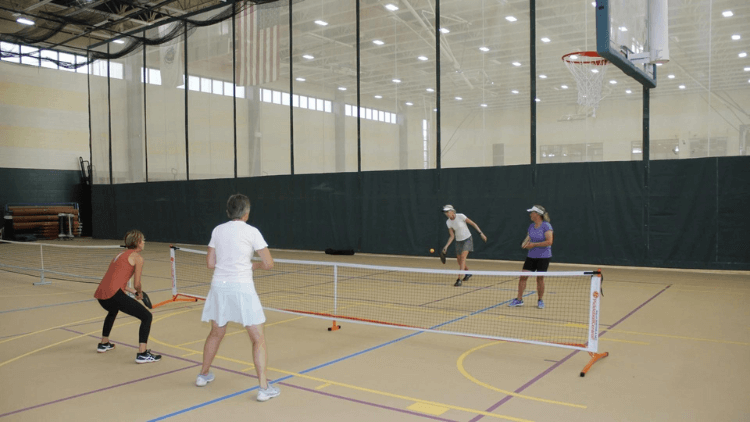
Frequently Asked Questions
The surface you use for your indoor pickleball courts should be smooth, durable and comfortable for players. Some common options are wood, vinyl, rubber or modular tiles. You should also consider the acoustics of your facility, as pickleball can be a noisy sport. You may want to use sound-absorbing materials or acoustic panels to reduce the echo and reverberation of the ball and paddle impacts.
Playing pickleball indoors has several advantages over playing outdoors. Indoor courts are protected from the weather, which means you can play year-round without worrying about rain, wind, sun or snow. Indoor courts also require less maintenance and are less affected by temperature and humidity changes. Indoor pickleball facilities may also offer amenities such as locker rooms, showers, restrooms, snack bars and equipment rentals.
The number of courts you need for an indoor pickleball facility depends on several factors, such as the size of your building, the demand for pickleball in your area and the type of courts you want to offer. Generally speaking, you can fit four pickleball courts in the same space as one tennis court. However, you may also want to consider adding some extra space for spectators, storage and circulation.
Conclusion
In conclusion, pickleball players of all ability levels may profit greatly from indoor pickleball facilities. Regardless of the weather, these designated areas offer a regulated atmosphere that permits play all year round. Multiple courts are frequently available in indoor facilities, allowing for simultaneous play and more opportunity for socialising and competitiveness. So choose a court nearby and start using the indoor court amenities that are available to you.
